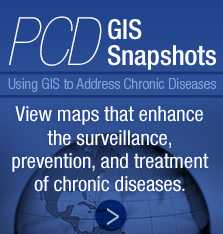
About the Journal
Preventing Chronic Disease (PCD) is a peer-reviewed electronic journal established by the National Center for Chronic Disease Prevention and Health Promotion. The mission of PCD is to promote the open exchange of information and knowledge among researchers, practitioners, policy makers, and others who strive to improve the health of the public through chronic disease prevention. The vision of PCD is to be the premier forum where practitioners and policy makers inform research and researchers help practitioners and policy makers more effectively improve the health of the population. Articles focus on preventing and controlling chronic diseases and conditions, promoting health, and examining the biological, behavioral, physical, and social determinants of health and their impact on quality of life, morbidity, and mortality across the life span.
PCD Quick Stats
- Current Impact Factor 2.170 (2015)
- A Google Scholar Top 20 Public Health Journal
- Ranked 60 of 160 public health journals (2013)
- Indexed in PubMed, PubMed Central, and DOAJ
Our primary audience:
- Public health practitioners.
- Researchers of chronic disease prevention and control.
- Researchers of health promotion.
- Policy makers.
Our primary goals:
- To promote dialogue among researchers, practitioners, and policy makers on research findings and practical experience.
- To encourage interdisciplinary approaches that examine multiple dimensions of public health interventions.
- To encourage multisectoral partnerships that engage communities in translating public health science into effective interventions.
- To advance the fields of chronic disease prevention and health promotion by exploring new theories and concepts.
Preventing Chronic Disease: 2016 Year in Review

The Year in Review provides an overview of PCD’s accomplishments for the year 2016. Our success would not be possible without the cooperation of the many dedicated individuals who engage in activities that improve the health and well-being of communities around the globe. We extend our heartfelt thanks to all who have contributed to PCD’s success and will remain committed to bringing their experiences and perspectives together to advance the fields of chronic disease prevention and health promotion.
Preventing Chronic Disease: 2016 Year in Review [PDF – 2.8MB]
Scope of Interests
The primary topics of interest in Preventing Chronic Disease:
- Development, implementation, and evaluation of population-based interventions to prevent chronic diseases and control their impact on quality of life, morbidity, and mortality.
- Multidisciplinary and multisectoral approaches to chronic disease prevention and health promotion.
- Settings where individuals and communities engage in improving health behaviors.
- Behavioral, psychological, genetic, environmental, biological, and social determinants of health.
- Disparities in chronic disease among at-risk populations and interventions that eliminate these disparities.
- Policy and legislative development, implementation, and evaluation of interventions.
- Application of innovative multimedia technologies in chronic disease prevention and health promotion.
Inquiries about the suitability of a proposed manuscript may be sent with a brief abstract or synopsis to the editor by e-mail at pcdeditor@cdc.gov.
Types of Articles
Preventing Chronic Disease features the following types of articles:
- Implementation Evaluation
- Original Research
- Research Brief
- Systematic Review
- GIS Snapshots
- Community Case Study
- Special Topic
- Tools and Techniques
- Essay
- Letter
Please see detailed descriptions of Types of Articles in the “For Authors” section.
Glossary
At-risk populations: Racial/ethnic minority groups, people with low income, mothers and children, adolescents, adults, older people, people living with disabilities, and veterans.
Multidisciplinary: Public health, epidemiology, medicine, social work, psychology, anthropology, urban development, economics, nutrition, nursing, community development, and others.
Multisectoral: Public health, clinical medicine, housing, transportation, agriculture, planning, and others.
Chronic diseases: Defined broadly as conditions that last one year or more and require ongoing medical attention or limit activities of daily living or both. In addition to comprising physical medical conditions, chronic conditions also include problems such as substance abuse and addiction disorders, mental illnesses, dementia and other cognitive impairment disorders, and developmental disabilities (http://www.hhs.gov/ash/initiatives/mcc/mcc_framework.pdf [PDF – 234KB]).
Social determinants of health: Economics, social mores, housing, environment, insurance, community programs, medical systems, and population health-related policy.
Settings: Home, work, school, community, individual, group, health care, and others
For a complete list of journal staff, please click here.
The opinions expressed by authors contributing to this journal do not necessarily reflect the opinions of the U.S. Department of Health and Human Services, the Public Health Service, the Centers for Disease Control and Prevention, or the authors' affiliated institutions.
- Page last reviewed: September 8, 2017
- Page last updated: September 8, 2017
- Content source:
- Maintained By:



 ShareCompartir
ShareCompartir